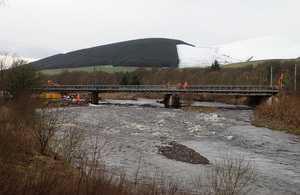Dangerous occurrence at Lamington Viaduct - Update
Investigation into trains passing over an undermined Lamington Viaduct, South Lanarkshire, 31 December 2015.

Image showing Lamington Viaduct
On the morning of Thursday 31st December 2015, several trains passed over Lamington Viaduct after the ground beneath a viaduct pier had been eroded by river scour. The viaduct carries the railway, running between Carstairs and Lockerbie, across the River Clyde. This is a two-track section of the West Coast Main Line between Glasgow and London where passenger trains are permitted to travel at up to 120 mph (193 km/h). Although there were no injuries or damage to trains, the viaduct was seriously damaged, and the main line remained closed for seven weeks while the structure was stabilised and repaired.
At 07:35 hrs, the driver of the southbound 06:52 Virgin West Coast service from Edinburgh Waverley to London Euston reported a dip in the track at Lamington Viaduct. Signallers required the drivers of the next train in each direction to examine the line while proceeding at reduced speed. Neither driver identified a fault but subsequent trains were instructed to proceed at reduced speed while track maintenance staff were being sent to site.
The track maintenance staff inspected the track on the viaduct and an adjacent section of track known to require regular adjustment. They found no significant defects and, after watching the next southbound train pass at reduced speed, they removed the speed restriction at 08:35 hrs and remained to monitor the line.
At 08:40 hrs, the maintenance staff saw unusual movements between carriages of the 05:57 Virgin West Coast service from Crewe to Glasgow Central as it crossed the viaduct on the northbound line at about 110 mph (177 km/h), and then observed that the passage of this train had caused “sweeping dips in the track” affecting both lines across the viaduct. They imposed temporary speed restrictions on trains in both directions, requested the attendance of a bridge examiner and went to inspect the viaduct piers. A final southbound train, the 08:12 First TransPennine Express service from Edinburgh to Manchester Airport, crossed the viaduct at low speed before the track maintenance staff closed the line to all trains at 08:53 hrs after discovering missing masonry and a large crack in pier number 2, one of three viaduct piers located in the river.
Subsequent investigation has revealed a large hole beneath pier number 2, subsidence of the pier and damage to steel bearings which support the bridge deck. The damage was discovered following exceptionally high water levels, and fast flows in the River Clyde due to Storm Frank, which impacted the UK on 29 - 30 December 2015. Evidence found to date suggests that the sweeping dips in the track were caused by deck movement related to the subsidence of pier 2, which probably occurred under the last northbound train at 08:40 hrs. The related scour damage may have been undiscovered since the river level peaked the previous day.
Our investigation will include examination of:
- actions in response to a scour risk assessment undertaken for Lamington Viaduct in 2005
- actions taken when the approach of Storm Frank resulted in warnings of exceptionally heavy rain, likely to cause fast flow in the River Clyde
- responses to the 31 December report of a track dip on the viaduct
- the effectiveness of Network Rail’s processes intended to mitigate risks to structures, including scour related risks, due to extreme weather
- any underlying management factors.
Our investigation is independent of any investigation by the railway industry or by the industry’s regulator, the Office of Rail and Road.
We will publish our findings, including any recommendations to improve safety, at the conclusion of our investigation. This report will be available on our website.
You can subscribe to automated emails notifying you when we publish our reports.
Updates to this page
-
Updated information on investigation
-
First published.